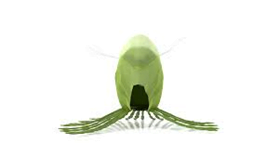Environment & Ecology
Context: Researchers at the University of Nebraska-Lincoln have reported that a particular genus of plankton, namely Halteria, can ‘grow and divide given only viruses to eat’.
About Halteria:

- Halteria — microscopic ciliates (a single-celled organism with minuscule hairs) that populate freshwater worldwide — can thrive wholly on a virus-only diet or ‘virovory’.
- Plankton of the genus Halteria can each consume 10,000 to a million virus particles a day, increase their population using the metabolised energy, and provide more food for the zooplanktons that consume the Halteria.
- Virovory is sufficient to support an organism’s physiological development and even population increase.
- They’re made up of nucleic acids, a lot of nitrogen and phosphorous.
Significance of Halteria:
- Halteria plankton are found in large numbers in freshwater bodies.
- They are heterotrophs meaning they can’t produce their own food.
- Instead, they are well-known bacterivores — they consume bacteria to power themselves.
- Viruses “short-circuit” the process of nutrients moving up the food chain.
- They infect and kill both bacteria and plankton, releasing organic matter that dissolves in the water.
- By also consuming viruses for nutrition, Halteria plankton can recover the nutrients lost in the viral shunt and bring them back into the food chain.
About Planktons:
- Plankton are usually microscopic, often less than one inch in length, but they also include larger species like some crustaceans and jellyfish.
- Scientists classify plankton in several ways, including by size, type, and how long they spend drifting.
- But the most basic categories divide plankton into two groups: phytoplankton (plants) and zooplankton (animals).
- Phytoplankton are microscopic plants, but they play a huge role in the marine food web.
- Like plants on land, phytoplankton perform photosynthesis to convert the sun’s rays into energy to support them, and they take in carbon dioxide and produce oxygen.
- Zooplankton include microscopic animals (krill, sea snails, pelagic worms, etc.), the young of larger invertebrates and fish, and weak swimmers like jellyfish.
- Most zooplankton eat phytoplankton, and most are, in turn, eaten by larger animals (or by each other).
- Krill may be the most well-known type of zooplankton; they are a major component of the diet of humpback, right, and blue whales.
- During the daylight hours, zooplankton generally drift in deeper waters to avoid predators.
- But at night, these microscopic creatures venture up to the surface to feed on phytoplankton.
Source: The Hindu
Previous Year Questions
Q.1) Consider the following kinds of organisms:
- Copepods
- Cyanobacteria
- Diatoms
- Foraminifera
Which of the above are primary producers in the food chains of oceans? (2021)
- 1 and 2
- 2 and 3
- 3 and 4
- 1 and 4
Q.2) Which of the following are detritivores?
- Earthworms
- Jellyfish
- Seahorse
- Woodlice
Select the correct answer using the code given below
- 1, 2 and 4 only
- 2, 3, 4 and 4 only
- 1, 3 and 5 only
- 1, 2, 3, 4 and 5













